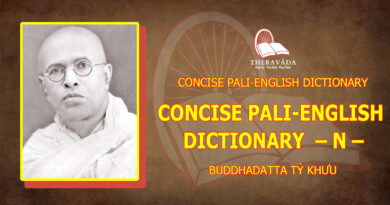Going For Refuge & Taking The Precepts – Xiii. The Undertaking Of Sila – Bhikkhu Bodhi
XIII. THE UNDERTAKING OF SILA
The Buddhist tradition recognizes three distinct ways of observing the precepts. One is called immediate abstinence (sampattavirati), which means abstaining from unwholesome actions naturally through an ingrained sense of conscience resulting either from an innately keen ethical disposition or from education and training. The second is called abstinence through undertaking (samadanavirati), which means abstaining as a result of having undertaken rules of training with a determination to follow those rules as guidelines to right action. The third way is called abstinence through eradication (samucchedavirati), which means abstaining from the transgressions covered by the precepts as a result of having cut off the defilements out of which transgressions arise.
For purposes of self-training Buddhism emphasizes the importance of the second type of abstinence. Immediate abstinence is seen as praiseworthy in itself but not sufficient as a basis for training since it presupposes the prior existence of a strong conscience, which is not a reality in the overwhelming majority of men. In order to develop the mental strength to resist the upsurge of the defilements it is essential to undertake the precepts by a deliberate act of will and to form the determination to observe them diligently.
There are two ways of formally undertaking the five precepts, the initial and the recurrent, corresponding to the two ways of going for refuge. The initial undertaking takes place immediately after the initial going for refuge. When the aspirant receives the three refuges from a bhikkhu in a formal ceremony, this will then be followed by the administering of the five precepts, the monk reciting each of the precepts in turn and the lay disciple repeating them after him. If there is no monk available to administer the refuges and precepts, the aspirant can take them upon himself by a strong and fixed mental resolution, preferably doing so before an image of the Buddha. The presence of a monk is not necessary but is generally desired to give a sense of the continuity of the lineage.
The undertaking of the precepts is not a one-shot affair to be gone through once and then dropped off into the storage bank of memories. Rather, like the going for refuge, the precepts should be undertaken repeatedly, preferably on a daily basis. This is the recurrent undertaking of the precepts. Just as the disciple repeats the three refuges each day to strengthen his commitment to the Dhamma, so he should recite the five precepts immediately after the refuges in order to express his determination to embody the Dhamma in his conduct. However, the practice of sila is not to be confused with the mere recitation of a verbal formula. The recitation of the formula helps reinforce one’s will to carry out the training, but beyond all verbal recitations the precepts have to be put into practice in day-to-day life, especially on the occasions when they become relevant. Undertaking the precepts is like buying a ticket for a train: the purchase of the ticket permits us to board the train but does not take us anywhere by itself. Similarly, formally accepting the precepts enables us to embark upon the training, but after the acceptance we have to translate the precepts into action.
Once we have formed the initial determination to cultivate sila, there are certain mental factors which then help to protect our observance of the precepts. One of these is mindfulness (sati). Mindfulness is awareness, constant attention and keen observation. Mindfulness embraces all aspects of our being — our bodily activities, our feelings, our states of mind, our objects of thought. With sharpened mindfulness we can be aware exactly what we are doing, what feelings and states of mind are impelling us towards particular courses of action, what thoughts form our motivations. Then, by means of this mindfulness, we can avoid the unwholesome and develop the wholesome.
Another factor which helps us maintain the precepts is understanding (pañña). The training in moral discipline should not be taken up as a blind dogmatic submission to external rules, but as a fully conscious process guided by intelligence. The factors of understanding give us that guiding intelligence. To observe the precepts properly we have to understand for ourselves which kinds of actions are wholesome and which are unwholesome. We also have to understand the reason why — why they are wholesome and unwholesome, why the one should be pursued and the other abandoned. The deepening of understanding enables us to see the roots of our actions, i.e., the mental factors from which they spring, and the consequences to which they lead, their long-term effects upon ourselves and others. Understanding expands our vision not only into consequences, but also into alternatives, into the different courses of action offered by any objective situation. Thence it gives us knowledge of the various alternatives open to us and the wisdom to choose some in preference to others.
A third factor that helps in maintaining the precepts is energy (viriya). The training in right conduct is at base a way of training the mind, since it is the mind that directs our actions. But the mind cannot be trained without effort, without the application of energy to steer it into wholesome channels. Energy works together with mindfulness and understanding to bring about the gradual purification of sila. Through mindfulness we gain awareness of our states of mind; through understanding we can ascertain the tendencies of these states, their qualities, roots and consequences; then through energy we strive to abandon the unwholesome and to cultivate the wholesome.
The fourth factor conducive to the training in sila is patience (khanti). Patience enables us to endure the offensive actions of others without becoming angry or seeking retaliation. Patience also enables us to endure disagreeable circumstances without dissatisfaction and dejection. It curbs our desires and aversions, restraining us from transgressions through greedy pursuits or violent reprisals.
Abstinence through eradication (samucchedavirati), the highest form of observing the precepts, comes about automatically with the attainment of the state of an ariyan, one who has reached direct realization of the Dhamma. When the disciple reaches the stage of stream-entry (sotapatti), the first of the ariyan stages, he becomes bound to reach full liberation in a maximum of seven more lives. He is incapable of reverting from the course of forward progress towards enlightenment. Simultaneously with his attainment of stream-entry the disciple acquires four inalienable qualities, called the four factors of stream-entry (sotapattiyanga). The first three are unshakable faith in the Buddha, the Dhamma, and the Sangha. The fourth is completely purified sila. The noble disciple has cut off the defilements which motivate transgressions of the precepts. Thus he can never deliberately violate the five precepts. His observance of the precepts has become “untorn, unrent, unblotched, unmotiled, liberating, praised by the wise, not clung to, conducive to concentration.”









